Colditz photo gallery
Here are some photographs taken during my last visits to Colditz in July 2006 and May 2007.
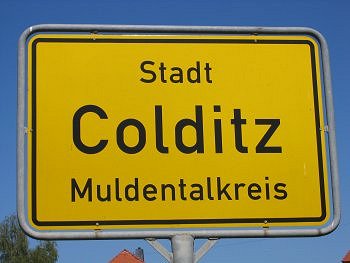 |
This sign tells you that you enter the built-up area of the town. |
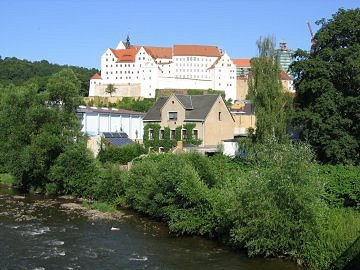 |
Colditz Castle, seen from the bridge over the Mulde river. |
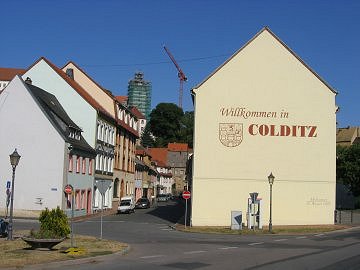 |
"Welcome in Colditz" This is the first impression of Colditz town after you cross the bridge over the Mulde river. On the left is the street Badergasse which leads to the market square. On 13 August 2002 the river has overflowed its banks and the Badergasse was flooded completely. At the right on the side-façade a line marked the water level during that flood. |
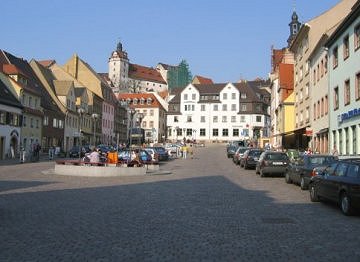 |
Colditz Castle is situated on a hill at the east side of the Markt (Market Square). The most convenient way to reach the castle is to climb the stairs left of the Sparkasse (banking house), the white building on the background. |
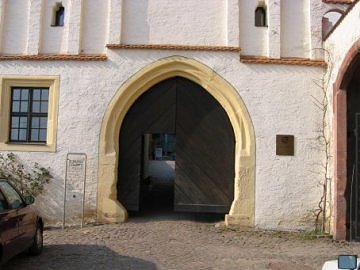 |
At the end of the stairs, turn left and you will soon reach the main entrance which is shown here. |
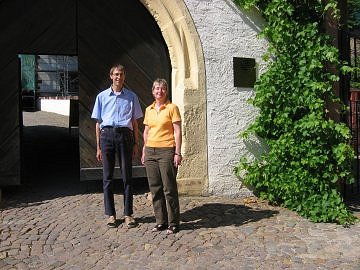 |
In 2006 it was exactly 20 years ago that I visited Colditz for the first time. This "jubilee" was a good reason for me to spend some days in Colditz in July 2006. Here I am standing in front of the main gate, together with Renate Lippmann from the Escape Museum. The colour of Renate's shirt was not a coincidence! (orange is the national colour of the Netherlands) |
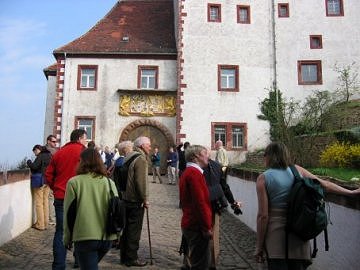 |
After passing the main entrance, you walk on the bridge over the moat. The moat was dry and was used by escaped officers more than one time. In front of you is the gate which leads to the first court yard. Above the gate is the coat of arms of the Duke of Saxony (left) and Princess Anna of Denmark (right). |
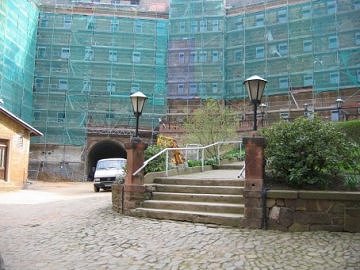 |
View at the first courtyard (during the war this was the so-called German courtyard). The rooms in the background were used as the German Kommandantur. This part of the castle is now the youth hostel but on this photograph, taken in April 2005, the renovation was not finished yet. The gate in the background leads to the park, the area which could be visited by the prisoners (needless to say, under heavy guarding only). |
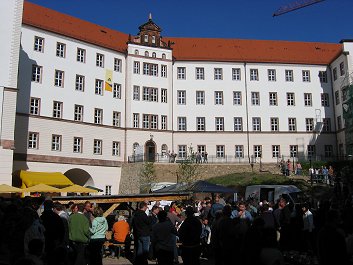 |
The youth hostel opened on 1 April 2007. I took this photograph exactly one month later when the building was open for visitors to have a look inside. The youth hostel has 161 beds, mainly in 4- and 6-bed rooms. Other features are a dining room, a disco, a terrace, a table tennis room and a cinema. There are 5 rooms for conferences or lectures. |
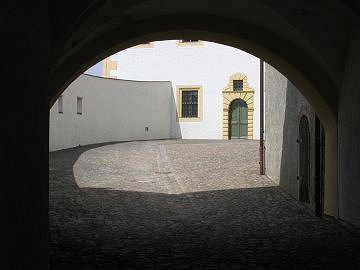 |
If you continue your way from the first courtyard, you enter a gallery which leads to the former prisoner's courtyard. On the background is the former guard house which is now a part of the Escape Museum. If you turn right at the end of the gallery, you pass a gate which gives access to the prisoner's courtyard. |
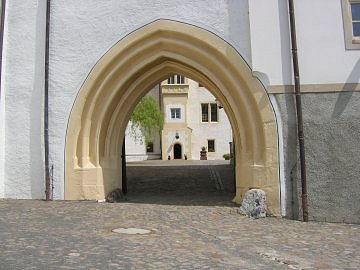 |
This is the gate to the prisoner's courtyard. On the background is an extension with the entrance to the Dutch quarters. The gate is known as Flüsterbogen ("Whispering arch"): if you stand at one side and whisper into the arch, someone at the other side can hear it clearly. |
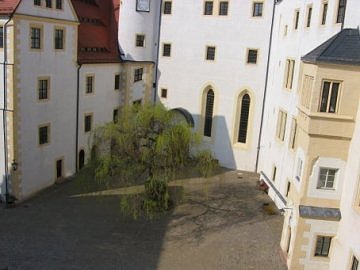 |
View at the prisoner's courtyard, looking north. On the left were some solitary confinement cells, the parcels office and the sick ward. In the background is the chapel and at the right the entrance to the Dutch quarters (compare with the previous photograph). |
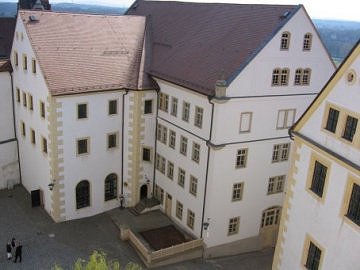 |
This is the south-west side of the prisoner's courtyard. The building in the middle is the Saalhaus which houses the theatre (third floor). The black square in the foreground marks the location of the delousing shed. The opening at the right leads to the gate, the only place where you can enter and leave the prisoner's courtyard. |
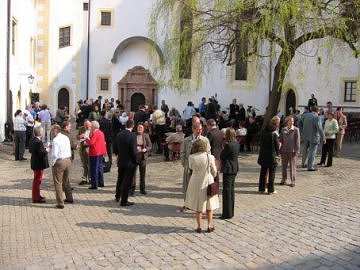 |
On the occasion of the ceremony to mark the 60th anniversary of the liberation of Colditz Castle on 16 April 2005, there was an official programme in the former prisoner's courtyard. This photograph was taken shortly before the speeches began in the sun-drenched courtyard. Due to the high number of English speaking guests, the German speeches were translated into English by an interpreter. |
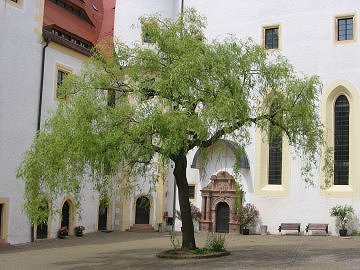 |
The weeping willow was planted in 1956 and due to disease it was cut down in September 2010. Next to the tree is the entrance to the chapel. |
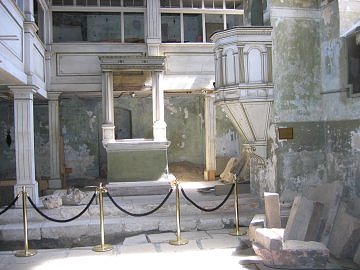 |
The chapel's interior. In spite of all the renovation works, the chapel remains untouched up till now. |
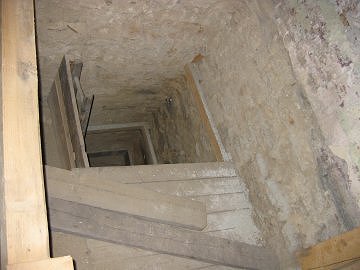 |
The French tunnel passed the chapel. The construction took months but it was discovered by the Germans shortly before it was finished. |
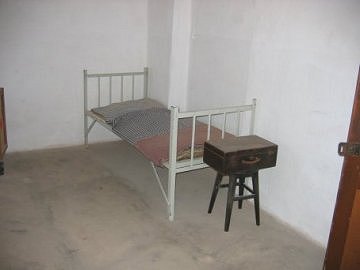 |
Punished officers were locked up in one of the solitary confinement cells. There were not many cells so there was a waiting list! Officers involved in an escape attempt were "rewarded" with three weeks of solitary confinement. The photograph is taken in the museum and shows a reconstruction of a solitary confinement cell. |
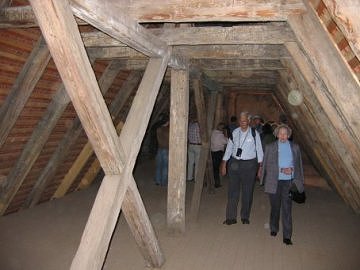 |
The construction of the famous Colditz glider started in May 1944. The builders needed a secure workshop and the attic above the chapel was ideally situated. By January 1945 the glider was finished but the end of the war was in sight so the glider was never used. After the war the glider was destroyed, the photograph shows the part of the attic were it was built more than 60 years ago. |
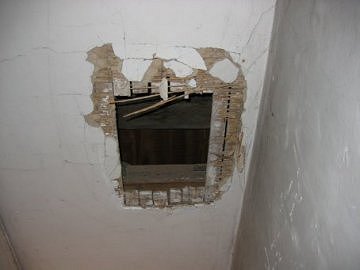 |
The so-called theatre escape was done by Airey Neave (British) and Tony Luteyn (Dutch). They hide under the theatre floor in January 1942 and via a hole in the floor under the stage they came in a small room at the end of an corridor. To conceal the hole, Pat Reid constructed a false ceiling panel (nicknamed Shovewood IV) so that the route could be used again. After the war the hole was repaired but today it is made visible again. |
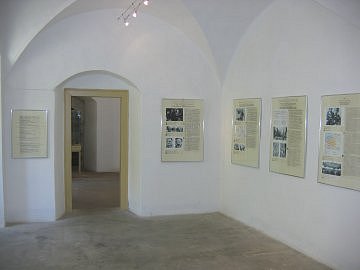 |
Impression of an exhibition room in the Escape Museum. |
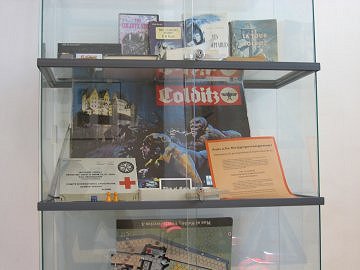 |
This is the Dutch version of the Colditz game which I donated to the museum during my visit in 2006. My friend Marco Jacobs bought it and we shared the purchase price. The game is in a showcase so all museum visitors can see it. |
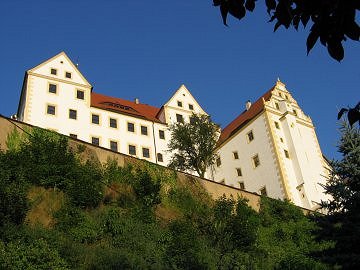 |
The last photograph, taken from the Haingasse, shows the west side of the castle. Again you can see clearly that the castle is situated on a hill. |